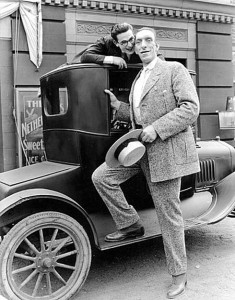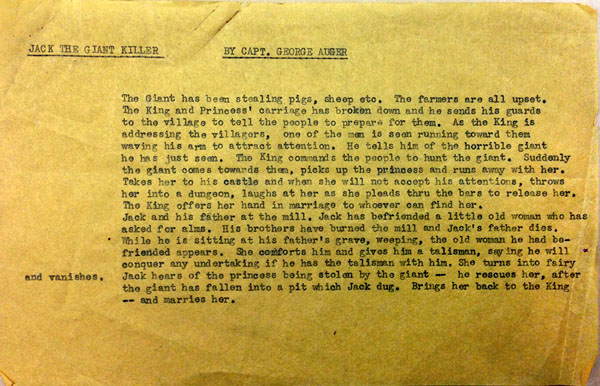
In my last column, I revealed an archival script for a Lantz cartoon that was never made, submitted by Captain George Auger, the former policeman and palace guard of Queen Victoria who became a circus and vaudeville star in the United States. He was often referred to as the Cardiff Giant, standing somewhere between seven and eight feet tall, a height that is hard to pin down exactly on account of so many dubious claims made by his promoters during his years with the Barnum & Bailey Circus.
 What remains equally mysterious is how exactly Walter Lantz came into this script purported to be written from a man who died in 1922. Auger had left the circus and wrote a play, Jack the Giant Killer, for which he was its larger-than-life star. He attained a huge degree of success with this swashbuckling stage melodrama, sustaining it for over ten years of performances in a long-running American tour of Orpheum vaudeville theaters.
What remains equally mysterious is how exactly Walter Lantz came into this script purported to be written from a man who died in 1922. Auger had left the circus and wrote a play, Jack the Giant Killer, for which he was its larger-than-life star. He attained a huge degree of success with this swashbuckling stage melodrama, sustaining it for over ten years of performances in a long-running American tour of Orpheum vaudeville theaters.
During the years of the First World War, he seems to have begun slowing his busy touring schedule and he settled down in a private estate called Maple Lawn Farm in Connecticut. He lived there with his wife Elizabeth, who went by Bertha. In fact, in one reference I found in the Oct. 2, 1915 edition of the Bridgeport Evening Farmer, their home was referred to as “Fairytale Farm.” Despite living in this bucolic retreat, they maintained a network of well-to-do friends and would travel out on social calls.
 Captain George Auger was an international celebrity and the sight of his towering approach made it impossible for him to ever keep his notice understated. I suppose that this, as much as anything, may have hastened his retreat to a Connecticut country farm for a few years. However, the thrill of being a circus star soon got the better of his leisure life, and after the merger of two circuses—forming the incomparable Ringling Bros. Barnum & Bailey Circus—he accepted a contract to be the Tallest Man in the World once again, wowing the adoring masses.
Captain George Auger was an international celebrity and the sight of his towering approach made it impossible for him to ever keep his notice understated. I suppose that this, as much as anything, may have hastened his retreat to a Connecticut country farm for a few years. However, the thrill of being a circus star soon got the better of his leisure life, and after the merger of two circuses—forming the incomparable Ringling Bros. Barnum & Bailey Circus—he accepted a contract to be the Tallest Man in the World once again, wowing the adoring masses.
He was touring and he was back in the limelight of fame. The year was 1922 and Hollywood might well have had some use for this giant man with the easy smile. In fact, he was actually signed to star in the Harold Lloyd comedy, Why Worry?, for which he was readying to take a train to California to begin this new chapter of his professional life in the movies. Sadly, with that opportunity almost at hand, he collapsed in a bathroom while visiting friends in New Jersey. He was soon pronounced dead, with the cause of death listed by some newspapers as indigestion.
As I mentioned in my last blog, I have wondered if Walter Lantz possibly met Auger within this time frame. Auger was in New York City to sign his contract with the Hal Roach Studio, and he also made time to have some fun and appear in promotional photographs with silent movie star Lloyd, among others. At this same time, Lantz was also living in New York City. He was working at the Bray Studios for the likes of directors George Stallings and Gregory La Cava.
Within a short time afterward, Lantz would have his own breakout opportunity in the movies, as the star of a series of film shorts in which he interacted with animated characters like Col. Heeza Liar, Dinky Doodle and Weakheart, all of these which he directed himself, becoming a recognized celebrity on the streets of New York. I always saw Walter’s persona in these Bray films as being most similar or imitative of Harold Lloyd. And yet, as much as circumstances may have allowed a meeting between Lantz and Auger, the likelihood still seems a stretch. And if they had met, it would have been fleeting.

Yet there the script resides in the UCLA Lantz archive, undeniably sent from Captain George Auger of Maple Lawn Farm in Bridgeport, Connecticut, according to the type-written header. A paragraph synopsis of Jack the Giant Killer also exists, clearly a carry-over from the successful vaudeville play. Years later, would Lantz consider making a cartoon based on this source material? Was there ever some notion of it being a tribute to the Cardiff Giant, the man who died tragically just before his Hollywood closeup?

If there is a candidate for such a film, it was made years later when Lantz was producing cartoons at Universal: The Magic Beans (1939). In this film, a mouse named Beany—who for all purposes seems to be the recurring character Babyface—initiates the planting of a magic beanstalk that sends him up into the clouds, where he meets an angry giant.
 At the end of this cartoon, the mouse yells to the audience, “If you folks think I’m gonna fight this big guy, you’re crazy!” He breaks the fourth wall of cinema and then storms past the man in the director’s chair filming this picture, leaving the giant sobbing just as he was to have earned his movie climax. As much as one could try to interpret that as a subtle homage, it simply is not. There is nothing about the feel of it that really warrants a serious consideration that it’s a tribute film or is in any way connected to Auger’s play.
At the end of this cartoon, the mouse yells to the audience, “If you folks think I’m gonna fight this big guy, you’re crazy!” He breaks the fourth wall of cinema and then storms past the man in the director’s chair filming this picture, leaving the giant sobbing just as he was to have earned his movie climax. As much as one could try to interpret that as a subtle homage, it simply is not. There is nothing about the feel of it that really warrants a serious consideration that it’s a tribute film or is in any way connected to Auger’s play.
Besides, Jack and the Beanstalk was a different version and a more American variant of the widely known eighteenth and nineteenth century fairytale. Auger’s play dispenses with the beanstalk and sticks to a version that he may have known more fondly as a boy growing up in his native Wales. In that version, set during the years of King Arthur’s reign, Jack settles a score with a Welsh giant who eats farmers’ livestock. The tale is supposed to demonstrate Jack’s trickery, ending with the death of the giant.
Perhaps a more plausible explanation is that, even after Auger’s death in 1922, Elizabeth Auger remained in Connecticut and maintained his estate, including the intellectual property of her late husband. Is it possible that she corresponded with the Lantz studio under his name or as Mrs. George Auger, understanding that Captain George Auger and his play still carried clout and recognition two decades after his passing? Almost certainly we will never know. This is a curiosity whose details now seem lost to time, but it can be interesting to speculate about it.
If there is any film that leaves the strongest mark of association, it is Woody the Giant Killer (1947). The storyline is purely Beanstalk, hardly a reference to the more British and Welsh variant of this fairytale, but the title would obviously tilt one’s eyebrow in wondering if Lantz was swayed by the script we know that he held at his studio: Jack the Giant Killer, a popular play that toured American cities starting in 1906. Perhaps one little boy who saw the play, mesmerized by its colossal star, was young Walter Lantz?


 Tom Klein is a Professor and the Chair of the Animation program at Loyola Marymount University, in Los Angeles. He has been published internationally and has been profiled in The New York Times for his work as a scholar of the Walter Lantz studio. He has worked at Vivendi-Universal Games and Universal Cartoon Studios. Follow him @VizLogic
Tom Klein is a Professor and the Chair of the Animation program at Loyola Marymount University, in Los Angeles. He has been published internationally and has been profiled in The New York Times for his work as a scholar of the Walter Lantz studio. He has worked at Vivendi-Universal Games and Universal Cartoon Studios. Follow him @VizLogic



















































Interesting idea that Lantz may have carried an awareness and affection for play from seeing it as a child. The more famous Walter saw a silent version of Snow White as a kid, and the memory seems to have kept the story front of mind.
Yes, that’s what strikes me as an intriguing possibility, knowing that (since Walter Lantz was born in 1899), he would have been the right age to catch the peak years of the touring show and to carry a boyhood fascination with the adventurism of Auger’s stage-play into adulthood, even if it never really manifested as a licensed animated remake. For years in elementary school, when I grew up in New Jersey, the first day of any new school year involved me intently listening to some kid who was lucky enough to have had a summer family vacation to Disney World/Epcot. I finally got to go myself after sixth grade, but the fascination I developed, studying books on Disney’s life in lieu of making the pilgrimage, surely has had some effect on me too, no? Here I am, a grown man in his forties writing about minute facets of classic cartoon lore! Citizen Klein, here’s your Rosebud.
It’s possible that when Lantz was considering producing a feature-length cartoon around 1940, he may have bought a number of story properties he felt had possibilities; and Captain Auger’s play may have been one of them.